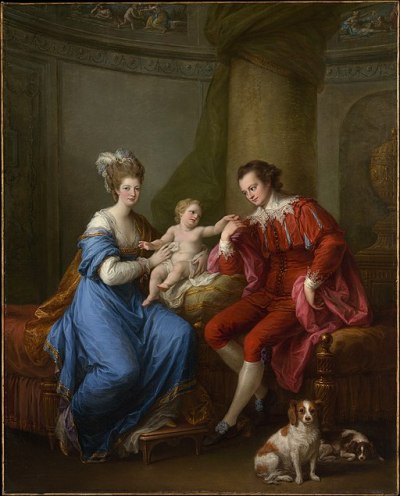After the burst of interest in 1773, no more quadrilles were advertised in London’s theatres until 3 May 1776 when the performance at Covent Garden included:
‘New Dance Call’d The Academy, in which will be introduced the New Court Minuet and Rigadoon (never perform’d before) by Mas. Holland and Miss Armstrong; with a Minuet and Allemande, by Mas. Daigueville, and a Girl only 5 years old; to conclude with a new Cadrille, by Sg and Sga Zuchelli, Dagueville, and Sga Vidini’.
In this case, the identification of a quadrille with a cotillon performed by only four dancers seems plausible. The performance was a benefit for ‘Dagueville’ (Peter D’Egville), described as ‘ballet master’ in the advertisement, so did he create this quadrille?
However, just a couple of years earlier, there had been a private performance of quadrilles which might have bought them back on stage, although they are not explicitly mentioned in any bills. On 9 June 1774, Lord Stanley (Edward Smith Stanley, later 12th Earl of Derby) had given a Fête Champêtre at his country seat The Oaks, near Epsom in Surrey to celebrate his forthcoming marriage to Lady Elizabeth Hamilton. The report in the General Evening Post, 9-11 June 1774, mentioned (among many other entertainments) ‘an infinite number of persons habited as peasants who attended swings and other amusements, and occasionally formed parties quarrees to dance quadrilles’. The description ‘parties quarrees’ suggests four couples dancing in a square. I couldn’t find individual portraits of the happy couple around the time of the Fête Champêtre, but here is a double portrait of them with their son painted by Angelica Kauffman in 1776.

Lord Stanley’s entertainment later became part of a play by John Burgoyne, The Maid of the Oaks, first performed at Drury Lane on 5 November 1774. A review in the Westminster Magazine for November 1774 sets out the plot and describes its divertissements:
‘After some superb exhibitions of transparent scenery, several characteristic airs, and elegant dances, Mr Oldworth … proclaims Maria his only daughter and gives her to Sir Harry. After a dance of Cupids, Hymen, &c. … offering them eternal wreaths, the Druid of the Oaks, freed by the present powers of Beauty from that sequestered habitation to which by mystic spells he had long been doomed, appears to ratify their union, and astonishes the spectators by his magic influence, in a glorious vision of that felicity the virtues of the happy pair had so justly insured. An admirable vaudeville, and a grand dance, conclude the dramatic entertainment’.
Cupid, Hymen and the Druid had all featured in Lord Stanley’s Fête Champêtre. The published text of the play makes clear that some of the scenes seen on stage represented the gardens and temporary buildings which had formed its backdrop the previous June. This print shows the ballroom designed and erected by Robert Adam for the occasion.

The advertisement for the first performance of The Maid of the Oaks told would-be audiences that the piece would include a ‘Fête Champêtre’ with singing and dancing – ‘The Dances by Slingsby … Atkins, Como, Giorgi, Sga Crespi, Mrs Sutton, &c. and Sga Hidou, … The Ballets by M. Larevier’. The distinction between ‘Dances’ and ‘Ballets’ is interesting and perhaps reflects a difference between the choreographies performed by the guests at the Fête and the divertissement dances given by the professionals. Another source tells us that the Ballets were ‘very Grand’. There is no mention of quadrilles either on the bills or in the printed text. The latter refers only to ‘a Grand Dance of Shepherds and Shepherdesses’ at the end of act two, a ‘Country Dance’ towards the end of act four, and a Minuet at the beginning of act five – which ends with the ‘Grand Dance’. Perhaps the ‘Country Dance’ was actually a quadrille.
I am inclined to believe that The Maid of the Oaks did include quadrilles, if only because on 31 August 1774 the Daily Advertiser Carried the following announcement:

The Morning Chronicle for 22 November 1774 announced that Delatre’s New Set of Cotillons was to be published that day, with its ‘first published’ quadrille. Delatre may well have been making use of the publicity surrounding Lord Stanley’s Fête Champêtre. Was he also capitalizing on the dancing in The Maid of the Oaks? He may have been the Monsieur Delaître who danced at Drury Lane in the 1750s, beginning with Jean-Georges Noverre’s The Chinese Festival in 1755. He is one of the very few dancing masters for whom trade cards have survived. This is the most elaborate of three that are known and may date to the 1780s.

I had thought that two pieces on these early stage quadrilles would have been enough, but I found quite a bit of interesting material. A third piece will take the story forward to the 1780s.
